<< Previous | Displaying results 6426-6450 of 6708 for "" | Next >>
-
Japanese American relocation
PhotoAmerican residents of Japanese ancestry wait with their luggage for transportation during relocation, San Francisco, California, April 6, 1942.
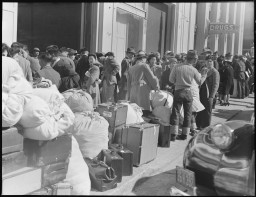
-
Sign hung in storefront of a Japanese American family's business
PhotoTatsuro Matsuda, whose family owned the Wanto Co. grocery store, hung this sign in front of the store, Oakland, California, March 1942. The store was closed following orders for the evacuation of Americans of Japanese ancestry. Evacuees were forcibly deported to relocation centers.

-
Japanese Americans in line to register with the War Relocation Authority
PhotoJapanese Americans wait in line to register with the War Relocation Authority, San Francisco, California, April 1942. A government agency, the War Relocation Authority was tasked with removing “enemy aliens” from designated zones. Local authorities on the West Coast forced all “persons of Japanese ancestry” to register. They were then deported, first to temporary “assembly centers” and from there to relocation centers.

-
Group portrait of students in an English language class for deaf immigrants
PhotoHilda Rattner (born Hilda Wiener ) was born into a Jewish family in Vienna on June 14, 1904. Not long after her birth, Hilda’s parents realized that she was deaf. Two years later, their fourth child, Richard, was born, and he was also deaf. Vienna in particular had a very vibrant deaf community where Jews and non-Jews mixed freely. Hilda and her brother Richard attended a Jewish school, where they learned to sign, and it was through these associations and activities that Hilda met Isadore Rattner, a…
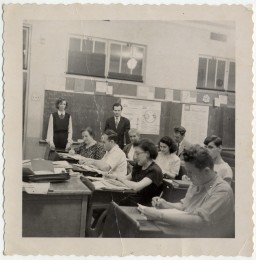
-
Portrait of Helen Keller
PhotoPortrait of Helen Keller, seated, reading Braille. September 1907. In 1933, Nazi students at more than 30 German universities pillaged libraries in search of books they considered to be "un-German." Among the literary and political writings they threw into the flames during the book burning were the works of Helen Keller.
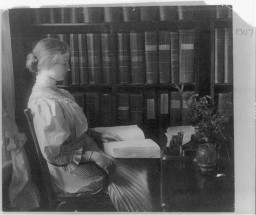
-
S-21 (Tuol Sleng) Prison, Cambodia
PhotoThe most notorious of the 189 known interrogation centers in Cambodia was S-21, housed in a former school and now called Tuol Sleng for the hill on which it stands. Between 14,000 and 17,000 prisoners were detained there, often in primitive brick cells built in former classrooms. Only 12 prisoners are believed to have survived.
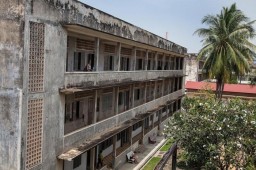
-
Frances Perkins
PhotoSecretary of Labor Frances Perkins testifies before the House Committee on migrant workers. Washington D.C., December 1940.

-
Lois Gunden and staff of the Ville St. Christophe refugee children’s home
PhotoLois Gunden (center right) with other members of the Ville St. Christophe staff in Canet-Plage, France. At the age of 26, Lois Gunden, a Mennonite and French teacher from Goshen, Indiana, sailed to Europe to head the Ville St. Christophe refugee children’s home in Canet-Plage, France. She had not been involved with overseas relief work before, and had never been to Europe. But she spoke French, and the Mennonite Central Committee needed someone willing to place herself in danger to help others.…
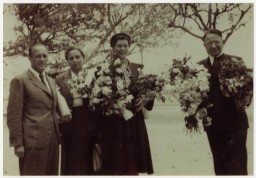
-
Instructions posted during Japanese American relocation
PhotoA notice posted on a wall in San Francisco, California, lists “evacuation” instructions for the area’s Japanese American residents, 1942. They were deported, first to temporary “assembly centers,” and from there to relocation centers in remote areas of the United States.
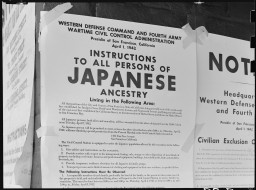
-
Army Military Police guard the Manzanar Relocation Center
PhotoArmy Military Police guarding the boundaries of the Manzanar Relocation Center in California, one of ten relocation camps where American residents of Japanese ancestry were forcibly deported, April 2, 1942.
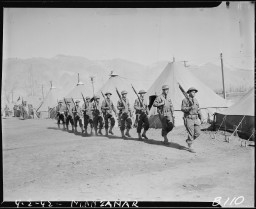
-
Town hall meeting at the Manzanar Relocation Center
PhotoJapanese Americans hold a town hall meeting at the Manzanar Relocation Center in California, 1943.
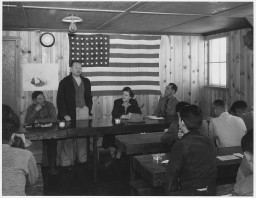
-
Nursery school children at the Heart Mountain Relocation Center
PhotoA group of nursery school children at the Heart Mountain Relocation Center in Wyoming, January 4, 1943. The Heart Mountain Relocation Center was one of ten relocation centers where Japanese Americans were forcibly deported.
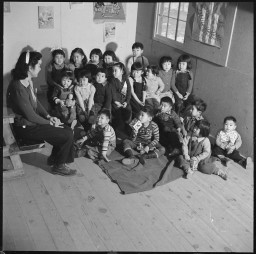
-
Painting entitled “Gassed,” By John Singer Sargent, 1919
PhotoWorld War I (1914–18) saw the first use of poison gas as a weapon of war. In this oil painting, John Singer Sargent depicted the aftermath of a mustard gas attack on British soldiers during a battle in August 1918. A line of soldiers, with bandaged eyes injured by the gas, hold on to one another as they are led to medical treatment. Around them are rows of other soldiers injured by the effects of the mustard gas, which could cause injuries such as burns and temporary blindness. © IWM (Art.IWM ART…

-
Scene of destruction during World War I
PhotoScene of destruction during World War I: panoramic view of the battlefield at Guillemont, September 1916, during the Battle of the Somme. © IWM (Q 1281)

-
Scene of destruction during World War I
PhotoHouses along the River Meuse damaged during the Battle of Verdun, December 1916. The battle was one of the longest and deadliest of World War I. © IWM (Q 67594)
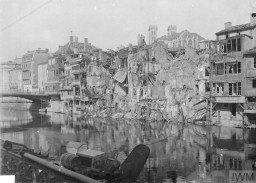
-
US soldiers during World War I
PhotoSurrounded by destruction, US soldiers of the 23rd Infantry fire a gun during World War I, 1918.
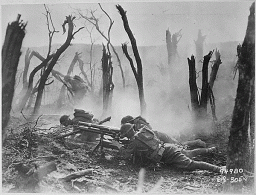
-
British soldiers in a trench during World War I
PhotoBritish troops in a trench cover the bodies of two fellow soldiers killed during the Battle of the Somme, November 1916. © IWM (Q 4393)

-
German troops marching in Berlin
PhotoThe first German troops to return from the conquests of Poland and France march through the Brandenburg Gate. Berlin, Germany, July 1940.

-
SS officers socialize at an SS retreat outside of Auschwitz
PhotoThis photograph shows a group of SS officers at Solahütte, the SS retreat outside of Auschwitz. Pictured from left to right: Richard Baer, Dr. Josef Mengele, and Rudolf Höss. From Karl Höcker's photograph album, which includes both documentation of official visits and ceremonies at Auschwitz as well as more personal photographs depicting the many social activities that he and other members of the Auschwitz camp staff enjoyed. These rare images show Nazis singing, hunting, and even trimming a Christmas…

-
Sergeant Leon Bass
PhotoSergeant Leon Bass and other members of the all African-American 183rd unit witnessed Buchenwald several days after liberation.

-
Weimar-era police search SA men for weapons
PhotoPolice search members of the SA (Sturmabteilung) for weapons as they gather for a rally. This photo was taken during the years of the Weimar Republic, before the Nazi rise to power. Germany, 1929–1932.

-
Closing of gay and lesbian bars in Nazi Germany
PhotoCollage created after the Nazi regime began to force gay and lesbian gathering spaces to close. It was published in the magazine, Der Notschrei. Berlin, March 1933.

-
Group portrait in the Ambloy children's home
PhotoGroup portrait at the Children's Aid Society (Oeuvre de Secours aux Enfants, OSE) home for Orthodox Jewish children in Ambloy, France. Among those pictured: Kalman Kalikstein (front left), Binem Wrzonski (middle right), and Elie Wiesel (back center). Photo dated 1945–1946.
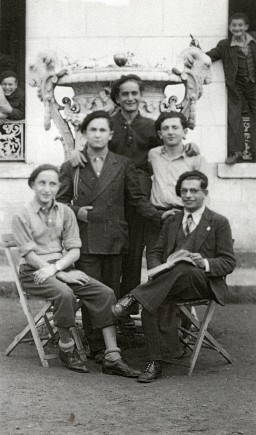
-
The Fink family in Westerbork
PhotoMichael Fink and his parents Manfred and Herta in the Westerbork camp, 1941–1944. Westerbork's primary role was as a transit camp. However, there was also a long-term camp population there. The Finks were among these residents. The family was in Westerbork until the spring of 1944, when they were deported to Theresienstadt. Michael and Herta survived, but Manfred was killed after being deported to Auschwitz-Birkenau and other concentration camps.
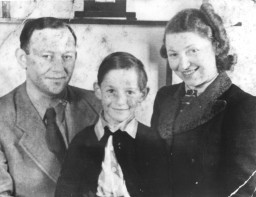
-
Magnus Hirschfeld
PhotoSigned portrait of German physician and sex researcher Magnus Hirschfeld (1868–1935). Hirschfeld sought to educate the public about sexuality. He advocated for the decriminalization of sexual relations between men, which was banned under Paragraph 175 of the German criminal code. Photo dated November 12, 1927.

